Dynamic Evaluation of Project Governance in Collaborative Innovation Projects: A Case of Industry Technology Research Institute
Abstract
:1. Introduction
2. Literature Review
2.1. The Governance of CIP
2.2. Network-Based Analysis
3. Research Methodology
3.1. Case Selection
3.2. Network Elements Identification
3.3. Network Construction
3.4. Network Analysis
3.4.1. Network-Level Analysis
3.4.2. Node Level Analysis
- (1)
- Key node indicators in the contractual relationship network
- (2)
- Key node indicators in the information relationship network
4. Results
4.1. Result of Network-Level Analysis
- (1)
- Contractual network
- (2)
- Information Network
4.2. Result of Node Level Analysis
- (1)
- Government node
- (2)
- Enterprise node
- (3)
- ITRI node and project manager node
5. Discussion
6. Conclusions and Future Research
Author Contributions
Funding
Institutional Review Board Statement
Informed Consent Statement
Data Availability Statement
Conflicts of Interest
References
- Tomala, F.; Sénéchal, O. Innovation management: A synthesis of academic and industrial points of view. Int. J. Proj. Manag. 2004, 22, 281–287. [Google Scholar] [CrossRef]
- Haefner, N.; Wincent, J.; Parida, V.; Gassmann, O. Artificial intelligence and innovation management: A review, framework, and research agenda. Technol. Forecast. Soc. 2021, 162, 120392. [Google Scholar] [CrossRef]
- Zhang, W.; Jiang, Y.; Zhang, W. Capabilities for Collaborative Innovation of Technological Alliance: A Knowledge-Based View. IEEE Trans. Eng. Manag. 2021, 68, 1734–1744. [Google Scholar] [CrossRef]
- Ruoslahti, H. Complexity in project co-creation of knowledge for innovation. J. Innov. Knowl. 2020, 5, 228–235. [Google Scholar] [CrossRef]
- Obradović, V. Project Management Office in the Public Sector: A Conceptual Roadmap. Eur. Proj. Manag. J. 2022, 12, 63–70. [Google Scholar] [CrossRef]
- Hermann, R.R.; Mosgaard, M.; Kerndrup, S. The function of intermediaries in collaborative innovation processes: Retrofitting a Danish small island ferry with green technology. Int. J. Innov. Sustain. 2016, 10, 361–383. [Google Scholar] [CrossRef]
- Turner, R. How Does Governance Influence Decision Making on Projects and in Project-Based Organizations? Proj. Manag. J. 2020, 51, 670–684. [Google Scholar] [CrossRef]
- Muller, R. Project Governance; Gower Publishing, Ltd.: Hampshire, UK, 2009. [Google Scholar]
- Sandin, G.; Clancy, G.; Heimersson, S.; Peters, G.M.; Svanström, M.; Ten Hoeve, M. Making the most of LCA in technical inter-organisational R&D projects. J. Clean. Prod. 2014, 70, 97–104. [Google Scholar]
- Fanousse, R.I.; Nakandala, D.; Lan, Y. Reducing uncertainties in innovation projects through intra-organisational collaboration: A systematic literature review. Int. J. Manag. Proj. Bus. 2021, 14, 1335–1358. [Google Scholar] [CrossRef]
- Matinheikki, J.; Artto, K.; Peltokorpi, A.; Rajala, R. Managing inter-organizational networks for value creation in the front-end of projects. Int. J. Proj. Manag. 2016, 34, 1226–1241. [Google Scholar] [CrossRef]
- Littau, P.; Jujagiri, N.J.; Adlbrecht, G. 25 Years of Stakeholder Theory in Project Management Literature (1984–2009). Proj. Manag. J. 2010, 41, 17–29. [Google Scholar] [CrossRef]
- Eskerod, P.; Huemann, M.; Savage, G. Project Stakeholder Management—Past and Present. Proj. Manag. J. 2015, 46, 6–14. [Google Scholar] [CrossRef]
- Pitsis, T.S.; Sankaran, S.; Gudergan, S.; Clegg, S.R. Governing projects under complexity: Theory and practice in project management. Int. J. Proj. Manag. 2014, 32, 1285–1290. [Google Scholar] [CrossRef]
- Yang, X.; Wang, L.; Zhu, F.; Müller, R. Prior and governed stakeholder relationships: The key to resilience of inter-organizational projects. Int. J. Proj. Manag. 2022, 40, 64–75. [Google Scholar] [CrossRef]
- Müller, R.; Turner, J.R.; Andersen, E.S.; Shao, J.; Kvalnes, Ø. Governance and Ethics in Temporary Organizations: The Mediating Role of Corporate Governance. Proj. Manag. J. 2016, 47, 7–23. [Google Scholar] [CrossRef]
- Turner, R.; Müller, R. The Governance of Organizational Project Management; Cambridge University Press: Cambridge, UK, 2017. [Google Scholar]
- Kujala, J.; Aaltonen, K.; Gotcheva, N.; Lahdenpera, P. Dimensions of governance in interorganizational project networks. Int. J. Manag. Proj. Bus. 2021, 14, 625–651. [Google Scholar] [CrossRef]
- Derakhshan, R.; Turner, R.; Mancini, M. Project governance and stakeholders: A literature review. Int. J. Proj. Manag. 2019, 37, 98–116. [Google Scholar] [CrossRef]
- Musawir, A.U.; Abd-Karim, S.B.; Mohd-Danuri, M.S. Project governance and its role in enabling organizational strategy implementation: A systematic literature review. Int. J. Proj. Manag. 2020, 38, 1–16. [Google Scholar] [CrossRef]
- Ahola, T.; Ruuska, I.; Artto, K.; Kujala, J. What is project governance and what are its origins? Int. J. Proj. Manag. 2014, 32, 1321–1332. [Google Scholar] [CrossRef]
- Liu, L.; Zhao, M.; Fu, L.; Cao, J. Unraveling local relationship patterns in project networks: A network motif approach. Int. J. Proj. Manag. 2021, 39, 437–448. [Google Scholar] [CrossRef]
- Wen, Q.; Qiang, M.; Gloor, P. Speeding up decision-making in project environment: The effects of decision makers’ collaboration network dynamics. Int. J. Proj. Manag. 2018, 36, 819–831. [Google Scholar] [CrossRef]
- Wang, D.; Fang, S.; Li, K. Dynamic changes of governance mechanisms in mega construction projects in China: The mediating role of opportunism. Eng. Constr. Archit. Manag. 2019, 26, 723–735. [Google Scholar] [CrossRef]
- Hsu, J.S.; Li, Y.; Sun, H. Exploring the interaction between vertical and shared leadership in information systems development projects. Int. J. Proj. Manag. 2017, 35, 1557–1572. [Google Scholar] [CrossRef]
- Turner, R.; Zolin, R. Forecasting Success on Large Projects: Developing Reliable Scales to Predict Multiple Perspectives by Multiple Stakeholders over Multiple Time Frames. Proj. Manag. J. 2012, 43, 87–99. [Google Scholar] [CrossRef]
- Mazur, A.K.; Pisarski, A. Major project managers’ internal and external stakeholder relationships: The development and validation of measurement scales. Int. J. Proj. Manag. 2015, 33, 1680–1691. [Google Scholar] [CrossRef]
- Zhang, S.; Zhang, S.; Gao, Y.; Ding, X. Contractual Governance: Effects of Risk Allocation on Contractors’ Cooperative Behavior in Construction Projects. J. Constr. Eng. Manag. 2016, 142, 4016005. [Google Scholar] [CrossRef]
- Temizkan, O.; Kumar, R.L. Exploitation and Exploration Networks in Open Source Software Development: An Artifact-Level Analysis. J. Manag. Inf. Syst. 2015, 32, 116–150. [Google Scholar] [CrossRef]
- Ke, H.; Cui, Z.; Govindan, K.; Zavadskas, E.K. The Impact of Contractual Governance and Trust on EPC projects in Construction Supply Chain Performance. Eng. Econ. 2015, 26, 349–363. [Google Scholar] [CrossRef]
- Reuer, J.J.; Ariño, A. Strategic alliance contracts: Dimensions and determinants of contractual complexity. Strateg. Manag. J. 2007, 28, 313–330. [Google Scholar] [CrossRef]
- Benítez-Ávila, C.; Hartmann, A.; Dewulf, G.; Henseler, J. Interplay of relational and contractual governance in public-private partnerships: The mediating role of relational norms, trust and partners’ contribution. Int. J. Proj. Manag. 2018, 36, 429–443. [Google Scholar] [CrossRef]
- Pollack, J.; Matous, P. Testing the impact of targeted team building on project team communication using social network analysis. Int. J. Proj. Manag. 2019, 37, 473–484. [Google Scholar] [CrossRef]
- Yuan, J.; Chen, K.; Li, W.; Ji, C.; Wang, Z.; Skibniewski, M.J. Social network analysis for social risks of construction projects in high-density urban areas in China. J. Clean. Prod. 2018, 198, 940–961. [Google Scholar] [CrossRef]
- Liu, C.; Cao, J.; Wu, G.; Zhao, X.; Zuo, J. Interenterprise Collaboration Network in International Construction Projects: Evidence from Chinese Construction Enterprises. J. Manag. Eng. 2022, 38, 11. [Google Scholar] [CrossRef]
- Kim, C.; Song, J. Creating new technology through alliances: An empirical investigation of joint patents. Technovation 2007, 27, 461–470. [Google Scholar] [CrossRef]
- Davis, J.P.; Eisenhardt, K.M. Rotating Leadership and Collaborative Innovation: Recombination Processes in Symbiotic Relationships. Adm. Sci. Quart. 2011, 56, 159–201. [Google Scholar] [CrossRef]
- Mudambi, R.; Mudambi, S.M.; Navarra, P. Global Innovation in MNCs: The Effects of Subsidiary Self-Determination and Teamwork. J. Prod. Innov. Manag. 2007, 24, 442–455. [Google Scholar] [CrossRef]
- Soh, P. When do firms benefit from university-industry R and D collaborations?: The implications of firm R and D focus on scientific research and technological recombination. J. Bus. Ventur. 2013, 29, 807–821. [Google Scholar] [CrossRef]
- Fernandes, G.; Domingues, J.; Tereso, A.; Pinto, E. A Stakeholders’ Perspective on Risk Management for Collaborative University-Industry R&D Programs. Procedia Comput. Sci. 2021, 181, 110–118. [Google Scholar]
- Weiss, M.; Hoegl, M.; Gibbert, M. How Does Material Resource Adequacy Affect Innovation Project Performance? A Meta-Analysis. J. Prod. Innov. Manag. 2017, 34, 842–863. [Google Scholar] [CrossRef]
- Nieto, M.J.; Santamaría, L. The importance of diverse collaborative networks for the novelty of product innovation. Technovation 2007, 27, 367–377. [Google Scholar] [CrossRef]
- Tülin, E.; Michael, P.K.; Baohong, S. A Dynamic Model of Brand Choice When Price and Advertising Signal Product Quality. Mark. Sci. 2008, 27, 1111–1125. [Google Scholar]
- Giaccone, S.C.; Magnusson, M. Unveiling the role of risk-taking in innovation: Antecedents and effects. RD Manag. 2022, 52, 93–107. [Google Scholar] [CrossRef]
- Pinto, J.K. Project management, governance, and the normalization of deviance. Int. J. Proj. Manag. 2014, 32, 376–387. [Google Scholar] [CrossRef]
- McGrath, S.K.; Whitty, S.J. Redefining governance: From confusion to certainty and clarity. Int. J. Manag. Proj. Bus. 2015, 8, 755–787. [Google Scholar] [CrossRef]
- Garland, R. Project Governance: A Practical Guide to Effective Project Decision Making; Kogan Page Publishers: London, UK, 2009. [Google Scholar]
- Turner, R.J. The Handbook of Project-Based Management, 3rd ed.; McGraw-Hill: London, UK, 2009. [Google Scholar]
- Müller, R.; Pemsel, S.; Shao, J. Organizational enablers for governance and governmentality of projects: A literature review. Int. J. Proj. Manag. 2014, 32, 1309–1320. [Google Scholar] [CrossRef]
- Freeman, R.E. Strategic Management: A Stakholder Approach. J. Manag. Stud. 1984, 29, 131–154. [Google Scholar]
- Khoirunnisa, N.L.; Almahendra, R. Micro design in inter-organizational hybrid governance: A study on product adaptation, reverse knowledge transfer and integration mechanism. J. Knowl. Manag. 2022, 26, 873–894. [Google Scholar] [CrossRef]
- Pargar, F.; Kujala, J.; Aaltonen, K.; Ruutu, S. Value creation dynamics in a project alliance. Int. J. Proj. Manag. 2019, 37, 716–730. [Google Scholar] [CrossRef]
- Liu, L.; Yu, B.; Wu, W. The Formation and Effects of Exploitative Dynamic Capabilities and Explorative Dynamic Capabilities: An Empirical Study. Sustainability 2019, 11, 2581. [Google Scholar] [CrossRef]
- Willems, T.; van Marrewijk, A.; Kuitert, L.; Volker, L.; Hermans, M. Practices of isolation: The shaping of project autonomy in innovation projects. Int. J. Proj. Manag. 2020, 38, 215–228. [Google Scholar] [CrossRef]
- Brunet, M. Making sense of a governance framework for megaprojects: The challenge of finding equilibrium. Int. J. Proj. Manag. 2021, 39, 406–416. [Google Scholar] [CrossRef]
- Söderlund, J.; Sydow, J. Projects and institutions: Towards understanding their mutual constitution and dynamics. Int. J. Proj. Manag. 2019, 37, 259–268. [Google Scholar] [CrossRef]
- Steinmo, M.; Rasmussen, E. How firms collaborate with public research organizations: The evolution of proximity dimensions in successful innovation projects. J. Bus. Res. 2016, 69, 1250–1259. [Google Scholar] [CrossRef]
- Zaheer, A.; Bell, G.G. Benefiting from network position: Firm capabilities, structural holes, and performance. Strateg. Manag. J. 2005, 26, 809–825. [Google Scholar] [CrossRef]
- Rowley, T.J. Moving Beyond Dyadic Ties: A Network Theory of Stakeholder Influences. Acad. Manag. Rev. 1997, 22, 887–910. [Google Scholar] [CrossRef]
- Wasserman, S.; Faust, K. Social Network Analysis; John Wiley & Sons, Ltd.: Hoboken, NJ, USA, 1994. [Google Scholar]
- Dadpour, M.; Shakeri, E.; Nazari, A. Analysis of Stakeholder Concerns at Different Times of Construction Projects Using Social Network Analysis (SNA). Int. J. Civ. Eng. 2019, 17, 1715–1727. [Google Scholar] [CrossRef]
- Xue, X.; Zhang, X.; Wang, L.; Skitmore, M.; Wang, Q. Analyzing collaborative relationships among industrialized construction technology innovation organizations: A combined SNA and SEM approach. J. Clean. Prod. 2018, 173, 265–277. [Google Scholar] [CrossRef]
- Mitchell, R.K.; Agle, B.R.; Wood, D.J. Toward a Theory of Stakeholder Identification and Salience: Defining the Principle of Who and What Really Counts. Acad. Manag. Rev. 1997, 22, 853–886. [Google Scholar] [CrossRef]
- Zheng, X.; Le, Y.; Chan, A.P.C.; Hu, Y.; Li, Y. Review of the application of social network analysis (SNA) in construction project management research. Int. J. Proj. Manag. 2016, 34, 1214–1225. [Google Scholar] [CrossRef]
- Chinowsky, P.; Diekmann, J.; Galotti, V. Social Network Model of Construction. J. Constr. Eng. Manag. 2008, 134, 804–812. [Google Scholar] [CrossRef]
- Yang, Y.; Chan, A.P.C.; Darko, A.; Gao, R.; Zahoor, H. Factors affecting structural steelwork adoption from a project lifecycle perspective: The case of Hong Kong. J. Clean. Prod. 2019, 230, 634–646. [Google Scholar] [CrossRef]
- Fang, C.; Marle, F.; Xie, M.; Zio, E. An Integrated Framework for Risk Response Planning Under Resource Constraints in Large Engineering Projects. IEEE Trans. Eng. Manag. 2013, 60, 627–639. [Google Scholar] [CrossRef]
- Yin, R.K. Case Study Research: Design and Methods; John Wiley & Sons, Ltd.: Hoboken, NJ, USA, 2010; p. 108. [Google Scholar]
- Hollweck, T.; Yin, R.K. Case Study Research Design and Methods, 5th ed.; Sage: Thousand Oaks, CA, USA, 2016; p. 282. [Google Scholar]
- Stivala, A.D.; Koskinen, J.H.; Rolls, D.A.; Wang, P.; Robins, G.L. Snowball sampling for estimating exponential random graph models for large networks. Soc. Netw. 2016, 47, 167–188. [Google Scholar] [CrossRef]
- Wang, L.; Goh, M.; Ding, R.; Pretorius, L. Improved simulated annealing based risk interaction network model for project risk response decisions. Decis. Support Syst. 2019, 122, 113062. [Google Scholar] [CrossRef]
- Bu, Y.; Wang, E.; Bai, J.; Shi, Q. Spatial pattern and driving factors for interprovincial natural gas consumption in China: Based on SNA and LMDI. J. Clean. Prod. 2020, 263, 121392. [Google Scholar] [CrossRef]
- Gilsing, V.; Nooteboom, B. Density and strength of ties in innovation networks: An analysis of multimedia and biotechnology. Eur. Manag. Rev. 2005, 2, 179–197. [Google Scholar] [CrossRef]
- Lu, M. Node importance evaluation based on neighborhood structure hole and improved TOPSIS. Comput. Netw. 2020, 178, 107336. [Google Scholar] [CrossRef]
- Gao, S.; Song, X.; Ding, R. Promoting Information Transfer in Collaborative Projects through Network Structure Adjustment. J. Constr. Eng. Manag. 2020, 146, 04019108. [Google Scholar] [CrossRef]
- Dogan, S.Z.; Arditi, D.; Gunhan, S.; Erbasaranoglu, B. Assessing Coordination Performance Based on Centrality in an E-mail Communication Network. J. Manag. Eng. 2015, 31, 4014047. [Google Scholar] [CrossRef]
- Pryke, S. Social Network Analysis in Construction; Wiley: Chichester, UK, 2012. [Google Scholar]
- Seungjun Ahn, A.M.A.; Shokri, S.; ASCE, S.L.M.; Carl, T.; Haas, F.A.; Ralph, C.G.; Haas, F.A. Exploratory Study on the Effectiveness of Interface-Management Practices in Dealing with Project Complexity in Large-Scale Engineering and Construction Projects. Am. Soc. Civ. Eng. 2017, 2, 4016039. [Google Scholar]
- Obradović, V. Contemporary Trends in the Public Sector Project Management. Eur. Proj. Manag. J. 2018, 8, 52–56. [Google Scholar] [CrossRef]
- Wang, R. Information asymmetry and the inefficiency of informal ip strategies within employment relationships. Technol. Forecast. Soc. 2021, 162, 120335. [Google Scholar] [CrossRef]
- Guo, F.Q.; Yun, Z.; Chong, W. Study on Information Asymmetry and the Risks Initiated by it in the Supply Chain Finance. Appl. Mech. Mater. 2014, 496–500, 2827–2831. [Google Scholar]
- Bukoye, O.T.; Ejohwomu, O.; Roehrich, J.; Too, J. Using nudges to realize project performance management. Int. J. Proj. Manag. 2022, 40, 886–905. [Google Scholar] [CrossRef]
- Wickramasinghe, V.; Pathirana, H. Team Member Voluntary Turnover, Introduction of New Members and Project Performance. Eur. Proj. Manag. J. 2022, 12, 24–33. [Google Scholar] [CrossRef]
- Lappi, T.; Karvonen, T.; Lwakatare, L.E.; Aaltonen, K.; Kuvaja, P. Toward an Improved Understanding of Agile Project Governance. Proj. Manag. J. 2018, 49, 39–63. [Google Scholar] [CrossRef]
- Klessova, S.; Thomas, C.; Engell, S. Structuring inter-organizational R&D projects: Towards a better understanding of the project architecture as an interplay between activity coordination and knowledge integration. Int. J. Proj. Manag. 2020, 38, 291–306. [Google Scholar]
- Yang, N.; Song, Y.; Zhang, Y.; Wang, J. Dark side of joint R&D collaborations: Dependence asymmetry and opportunism. J. Bus. Ind. Mark. 2020, 35, 741–755. [Google Scholar]
- Hafezalkotob, A.; Khodabakhsh, M.; Saghaei, A.; Eshghipour, M. Cooperation of advertising companies in social networks: A graph and game theory approaches. Comput. Ind. Eng. 2018, 125, 212–220. [Google Scholar] [CrossRef]
- Malherbe, M. Cooperating in interorganizational innovation projects: Toward a better understanding of coupling with the permanent ecosystem. Int. J. Proj. Manag. 2022, 40, 871–885. [Google Scholar] [CrossRef]
- Liang, X.; Lu, W.; Wu, Z. Effects of collaboration networks on technology innovation in solar photovoltaic (PV) sector: A case study of China. J. Green. Build. 2020, 15, 19. [Google Scholar] [CrossRef]
- Zwikael, O.; Meredith, J.R. Who’s who in the project zoo? The ten core project roles. Int. J. Oper. Prod. Manag. 2018, 38, 474–492. [Google Scholar] [CrossRef]
- Cao, Z.; Lumineau, F. Revisiting the interplay between contractual and relational governance: A qualitative and meta-analytic investigation. J. Oper. Manag. 2015, 33–34, 15–42. [Google Scholar] [CrossRef]
- Galvin, P.; Tywoniak, S.; Sutherland, J. Collaboration and opportunism in megaproject alliance contracts: The interplay between governance, trust and culture. Int. J. Proj. Manag. 2021, 39, 394–405. [Google Scholar] [CrossRef]
- Van Den Hurk, M.; Verhoest, K. The governance of public–private partnerships in sports infrastructure: Interfering complexities in Belgium. Int. J. Proj. Manag. 2015, 33, 201–211. [Google Scholar] [CrossRef]
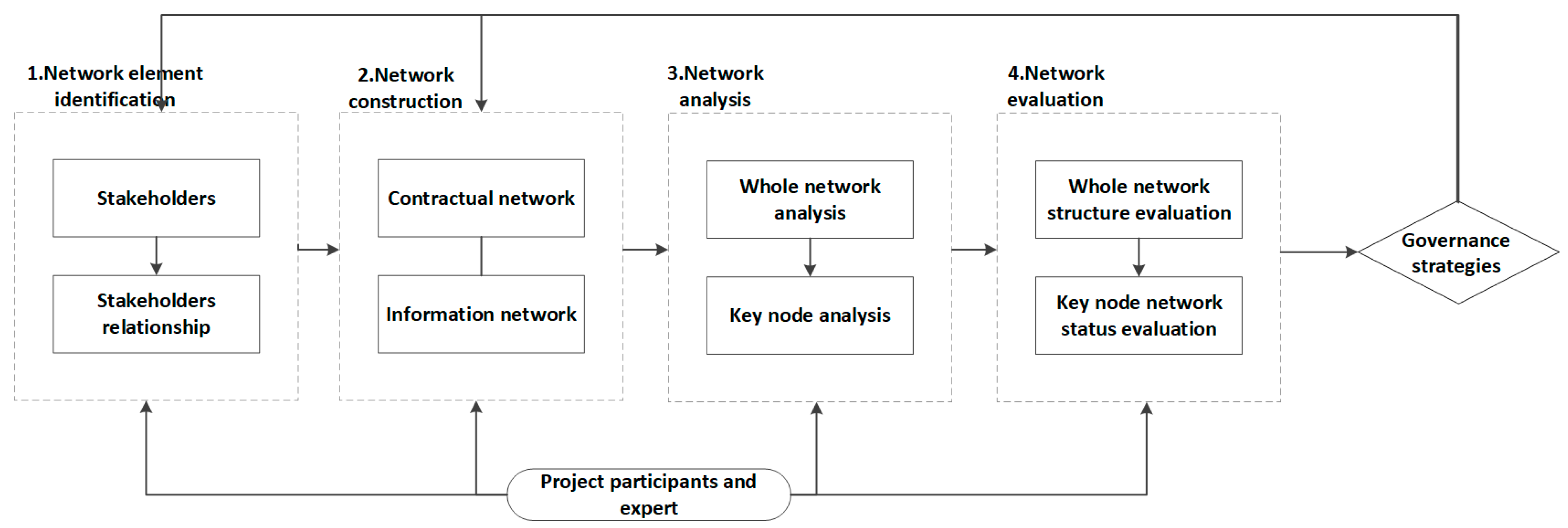
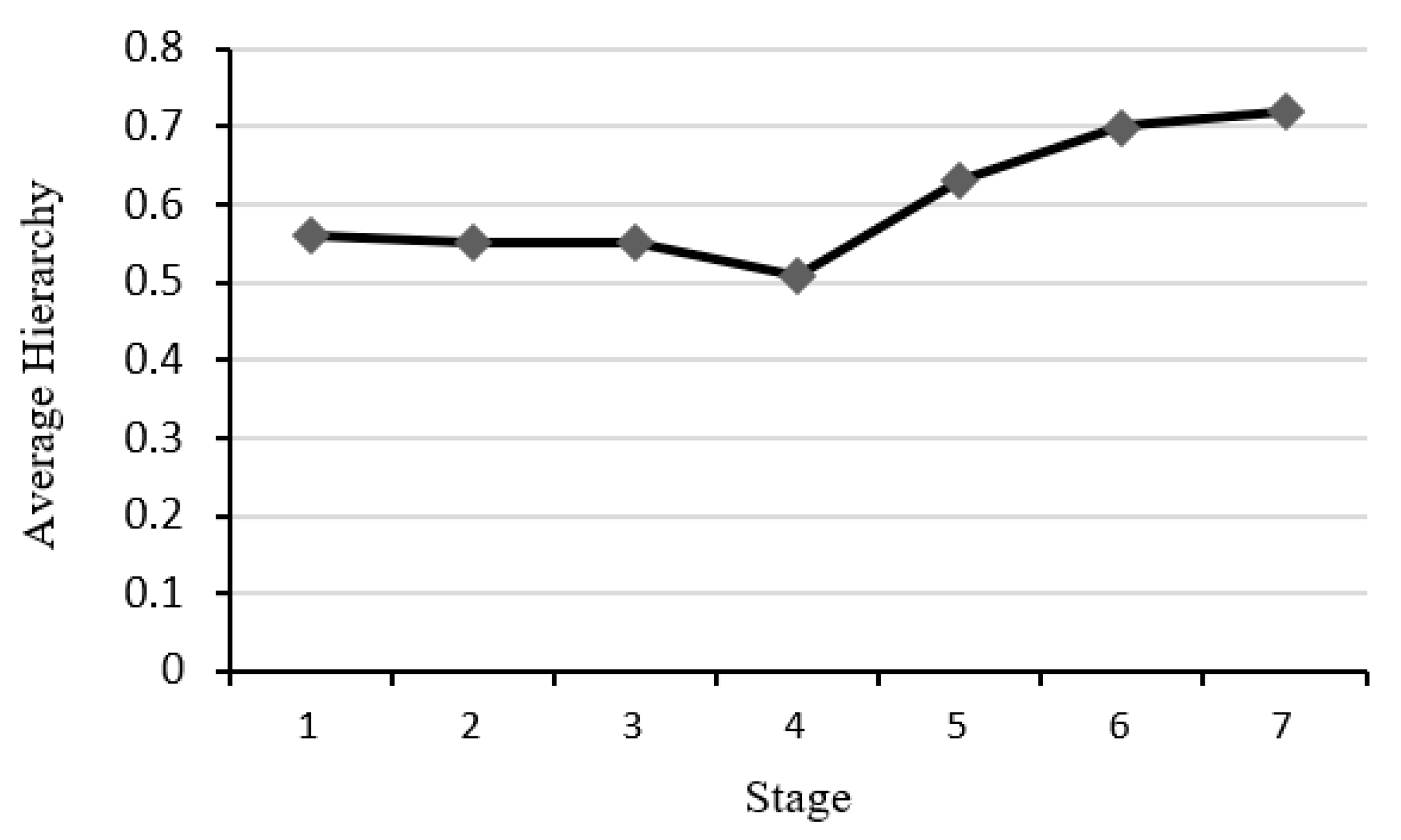
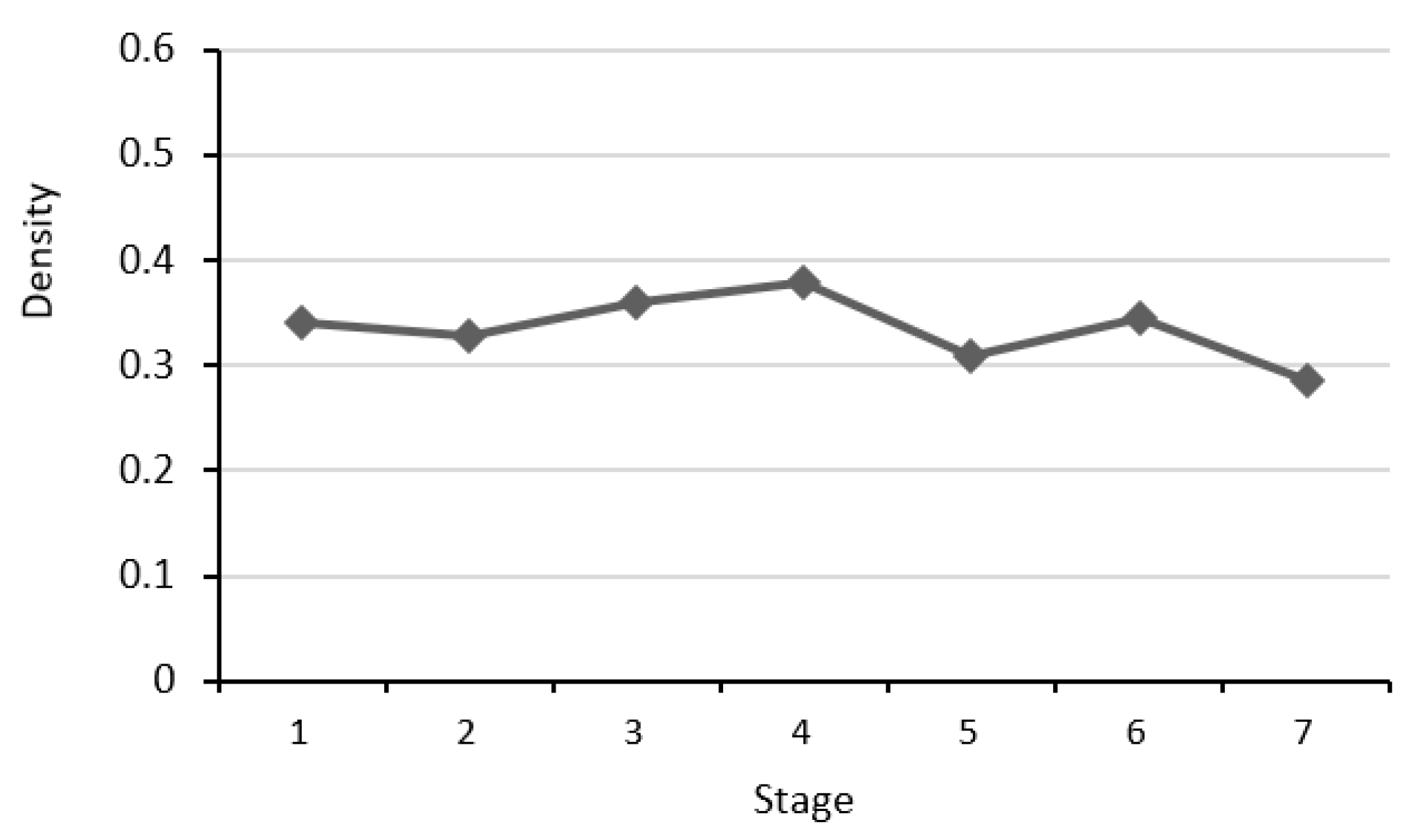
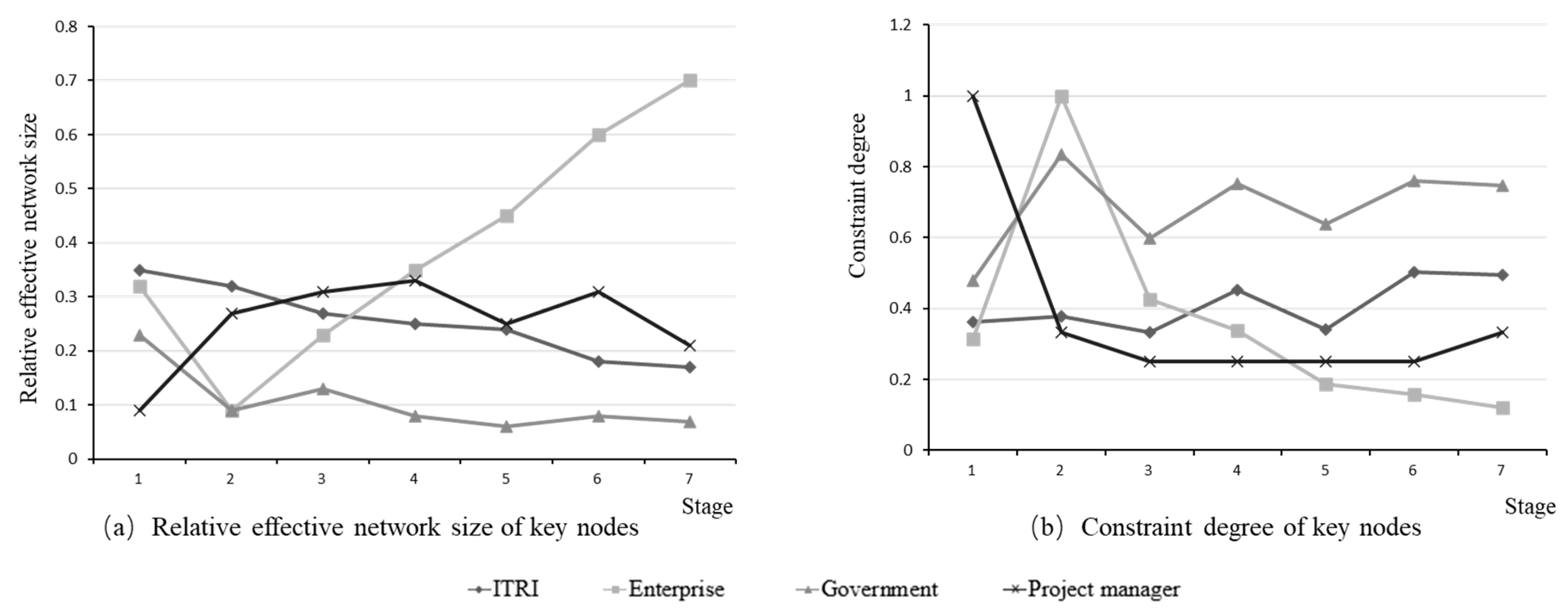
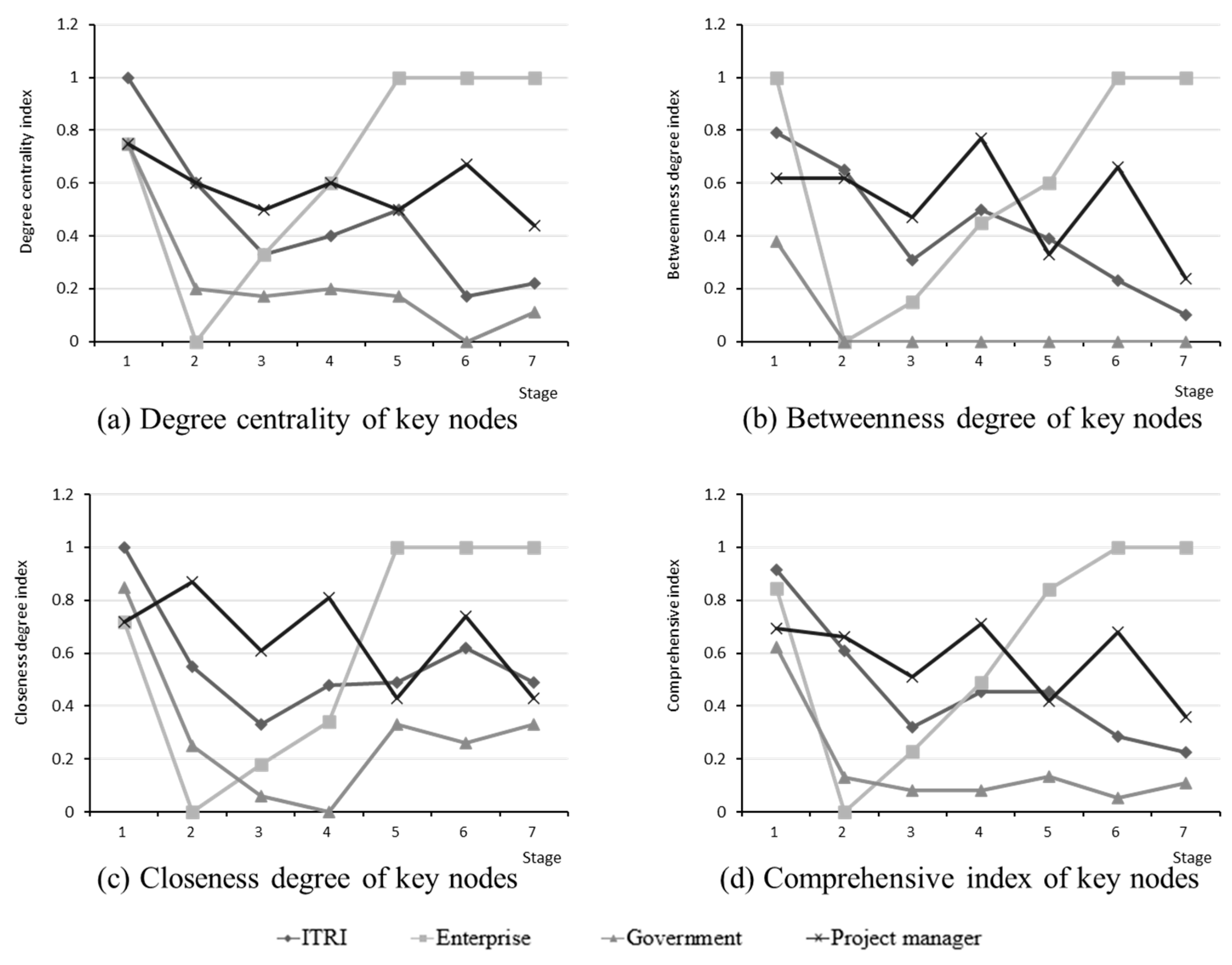
| No. | Role and Number of Interviewees | Specific Interview Topic | Duration |
|---|---|---|---|
| 1 | Project manager (1) | Project stage division and key stakeholders in the project | 2 h |
| 2 | ITRI (3) | Task, main responsibilities, stakeholders with collaborative relationships, and the type of relationship | 1.5 h |
| 3 | Enterprise (4) | Task, main responsibilities, stakeholders with collaborative relationships, and the type of relationship | 2 h |
| 4 | Basic research university (3) | Task, main responsibilities, stakeholders with collaborative relationships, and the type of relationship | 1 h |
| 5 | Applied research college (3) | Task, main responsibilities, stakeholders with collaborative relationships, and the type of relationship | 1 h |
| 6 | Government (1) | Task, main responsibilities, stakeholders with collaborative relationships, and the type of relationship | - |
| Stakeholders | No. | Stakeholders | No. | Stakeholders | No. |
|---|---|---|---|---|---|
| ITRI | A | Basic Researcher (PhD student) | C12 | Project Manager | G |
| Enterprise | B | Basic Researcher (master’s student) | C13 | Administrative Assistant | G1 |
| R&D Technology Department | B1 | Applied Research College | D | Theoretical Researcher | G2 |
| Production Department | B2 | Head of Patent Development (professor) | D1 | Patent Development, Prototype Designer | G3 |
| Equipment Management Department | B3 | Patent Development Researcher (PhD student) | D11 | Prototype Designer, Process Designer | G4 |
| Purchasing Department | B4 | Patent Development Researcher (PhD student) | D12 | Advanced Manufacturing Laboratory | H |
| Market Department | B5 | Prototype Designer, Process Expert (associate professor) | D2 | Supplier I | I |
| Basic Research Universities | C | Prototype Designer, Process Designer (master’s student) | D21 | Supplier II; | J |
| Head of Basic Research (professor) | C1 | Government | E | ||
| Basic Researcher (Ph.D.) | C11 | Bank | F |
| Stage | Task | Milestone | Stakeholders |
|---|---|---|---|
| Project initiation stage | The ITRI found opportunities for the project and initiated the project in conjunction with key stakeholders to obtain government support. | The government approves the project and decides to give policy support; cooperation agreements between stakeholders are signed | A, B, B1, C, C1, D, D1, D2, E, F, G |
| Orientation basic research stage | Organize and verify the theories related to the project technology to obtain basic data and related materials. | Complete “F Technology Theory Analysis Report” | A, B, C, C1, C11, C12, C13, E, G, G1, G2 |
| Applied research stage | Implement theoretical research results, and apply for related patents for product development. | Submit a patent application | A, B, B1, D, D1, D11, D12, D2, E, G, G1, G2, G3 |
| Prototype design stage | Determine the product’s function, and design the product structure and appearance. | Complete prototype interactive design | A, B, B1, B5, D, D2, D21, E, G, G1, G3, G4 |
| Laboratory environment trial production stage | Design product implementation plans, develop prototype processes, and conduct trial production in a laboratory environment. | Complete prototype production and expert review | A, B, B1, B2, B4, D, D2, D21, E, G, G1, G3, G4, H, I, J |
| Enterprise environment trial production stage | According to the corporate environment, design and manufacture processes, supporting related materials and equipment, and conduct trial production of the corporate environment. | Complete small batch trial production | A, B, B1, B2, B3, B4, E, G, G1, G3, G4, I, J |
| Commercialization stage | The enterprise fully absorbs relevant technologies and pushes products to the market to solve problems such as production change between products and material coordination. | Achieve product sales | A, B, B1, B2, B3, B4, B5, E, F, G, G1, G4, I, J |
| Stage | Contractual Network | Information Network |
|---|---|---|
| Project initiation stage |  | 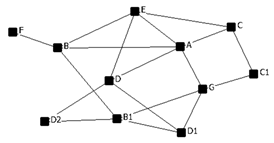 |
| Orientation basic research stage | 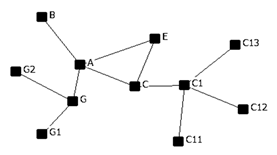 | 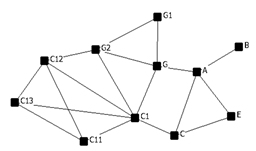 |
| Applied research stage |  | 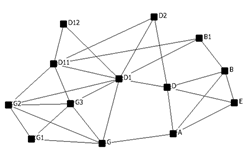 |
| Prototype design stage | 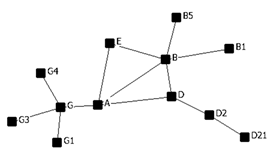 | 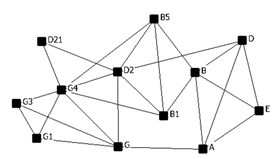 |
| Laboratory environment trial production stage | 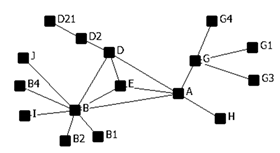 |  |
| Enterprise environment trial production stage |  | 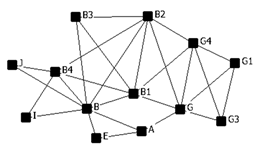 |
| Commercialization stage | 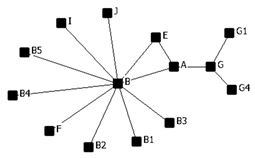 | 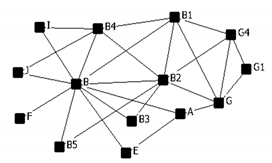 |
Disclaimer/Publisher’s Note: The statements, opinions and data contained in all publications are solely those of the individual author(s) and contributor(s) and not of MDPI and/or the editor(s). MDPI and/or the editor(s) disclaim responsibility for any injury to people or property resulting from any ideas, methods, instructions or products referred to in the content. |
© 2023 by the authors. Licensee MDPI, Basel, Switzerland. This article is an open access article distributed under the terms and conditions of the Creative Commons Attribution (CC BY) license (https://creativecommons.org/licenses/by/4.0/).
Share and Cite
Liu, Z.; Ding, R. Dynamic Evaluation of Project Governance in Collaborative Innovation Projects: A Case of Industry Technology Research Institute. Sustainability 2023, 15, 12493. https://doi.org/10.3390/su151612493
Liu Z, Ding R. Dynamic Evaluation of Project Governance in Collaborative Innovation Projects: A Case of Industry Technology Research Institute. Sustainability. 2023; 15(16):12493. https://doi.org/10.3390/su151612493
Chicago/Turabian StyleLiu, Zhixue, and Ronggui Ding. 2023. "Dynamic Evaluation of Project Governance in Collaborative Innovation Projects: A Case of Industry Technology Research Institute" Sustainability 15, no. 16: 12493. https://doi.org/10.3390/su151612493
APA StyleLiu, Z., & Ding, R. (2023). Dynamic Evaluation of Project Governance in Collaborative Innovation Projects: A Case of Industry Technology Research Institute. Sustainability, 15(16), 12493. https://doi.org/10.3390/su151612493





